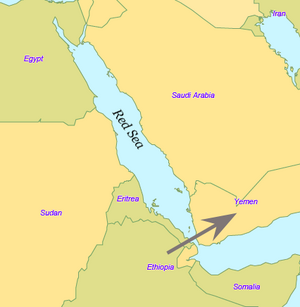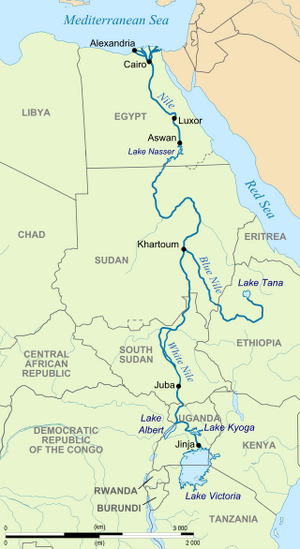Ethiopia
| Author:Laxman Burdak, IFS (R) |



Ethiopia (इथोपिया) is a country located in the Horn of Africa.
Variants
- Ethiopians (Anabasis by Arrian, p. 272, 317, 369, 399.)
- Æthiopia
- Abyssinia
- Abyssinia (Anabasis by Arrian, p. 272)
Location
It is bordered by Eritrea to the north and northeast, Djibouti and Somalia to the east, Sudan and South Sudan to the west, and Kenya to the south.
Origin of name
The Greek historian Herodotus specifically uses it for all the lands south of Egypt,[1] including Sudan and modern Ethiopia. Pliny the Elder says the country's name comes from a son of Hephaestus (aka Vulcan) named Aethiops.[2]
History
Some of the oldest evidence for anatomically modern humans has been found in Ethiopia,[3] which is widely considered the region from which Homo sapiens first set out for the Middle East and points beyond.[4][5][6] According to linguists, the first Afro-Asiatic-speaking populations settled in the Horn region during the ensuing Neolithic era.[7] Tracing its roots to the 2nd millennium BC, Ethiopia was a monarchy for most of its history. During the first centuries of the Common Era the Kingdom of Aksum maintained a unified civilization in the region.[8]
Ethiopia derived prestige for its uniquely successful military resistance during the late 19th-century Scramble for Africa, and subsequently many African nations adopted the colors of Ethiopia's flag following their independence. Ethiopia was the only African country to defeat a European colonial power and retain its sovereignty as an independent country.
Migrations from Indian to north western countries
Hukum Singh Panwar (Pauria)[9] writes that We may now cite at some length from Pococke[10] who has traced Indian migrations to all corners of the world solely through linguistic similarities. This extreme reliance on phonetic similarities seems to weaken his argument, but there is ample support, from other disciplines, techniques and lines of investigation, for his claims. Further, the large body of data, he has massed together cannot be brushed away lightly. When supported by other evidence, his thesis becomes incontrovertible. According to Pococke a great number of adventurous preux chevalier tribes from India migrated to Spain, Italy, Greece, Asia Minor,Persia, Colchis, Armenia and the Caucasus region, all of which provide distinct and startling evidence of Indian colonization in great profusio. We have tried (Appendix No.6) to pinpoint the Indian names and places of the origin of the migrated tribes as well as the altered forms of their names in their new settlements in other countries. The appendix indicating all this, is by no means, exhaustive. It may not be unnecessary here to point out that in some countries the presence of Indian tribes can be construed by their names, though distorted, while, in others their identity can be traced by place names in these transformed phonemic nomenclatures. All the more significant is the fact that almost all the tribes are considered Saca-Getae (Jats) or Scythians by the learned scholar[11].(cf. Appendix No.6).
Pococke[12] believes that the major migrations took place from India as a result of internecine wars and religious persecutions in which the Buddhists had been the main victims.
To these may be added the Parasurama-Haihayas (Scythians) wars, Sagar's war against Haihayas and their allies (Sakas, Parthas,Pahlavas etc) the Dasarajna Wars, the Rama-Ravana Yudha, the Mahabharata war. Pococke lays special stress on the virulent religious strife for a long time between the Brahmins and the Buddhists for supremacy, leading to Brahmanic victory and the gigantic expulsion of the Buddhists. Pococke claims[13] that this was the most crucial event which compelled migrations and
The Jats:Their Origin, Antiquity and Migrations:End of page 307
banishment of the vanquished to the north-western countries. The Saga of the Kurus and Pandus, though ostensibly political was in reality, as Pococke[14] contends, a struggle between the Brahminical and the Buddhistic parties. Profound night clouds this portion on Indian history. What Pococke regards as clear is that the emigrants coasted along the shores of Mekran, traversed the mouth of Persian Gulf. Adhering to the sea-board of Oman, Hadramant and Yemen (the Eastern Arabia), they sailed up the Red Sea, and ascending the mighty stream - the Nile - that fertilizes a land of wonders, founded the kingdoms of Egypt, Nubia, Abyssinia[15] and Ethiopia. Fhilostratus, Julius Africanus, Eusebius and Syncellus, the Greek writers[16] assert that the Ethiopians were originally an Indian race, emigrated from the river Indus and settled in the vicinity of Egypt. This assertion cannot be dismissed lightly.
Gallery
-
Map of Middle East Countries]]
References
- ↑ Histories, II, 29–30; III, 114; IV, 197
- ↑ Nat. Hist. 6.184–187; son of Hephaestus was also a general Greek epithet meaning "blacksmith" .
- ↑ Hopkin, Michael (16 February 2005). "Ethiopia is top choice for cradle of Homo sapiens". Nature. doi:10.1038/news050214-10
- ↑ Li, J. Z.; Absher, D. M.; Tang, H.; Southwick, A. M.; Casto, A. M.; Ramachandran, S.; Cann, H. M.; Barsh, G. S.; Feldman, M.; Cavalli-Sforza, L. L.; Myers, R. M. (2008). "Worldwide Human Relationships Inferred from Genome-Wide Patterns of Variation". Science 319 (5866): 1100–1104. Bibcode:2008Sci...319.1100L.
- ↑ http://www.bloomberg.com/apps/news?pid=newsarchive&sid=awJVkvnk8KjM&refer=australia
- ↑ Kaplan, Karen (21 February 2008). "Around the world from Addis Ababa". Los Angeles Times. Startribune.com.
- ↑ Zarins, Juris (1990). "Early Pastoral Nomadism and the Settlement of Lower Mesopotamia". Bulletin of the American Schools of Oriental Research 280: 31–65. JSTOR 1357309.
- ↑ Ancient India, A History Textbook for Class XI, Ram Sharan Sharma, National Council of Educational Research and Training, India
- ↑ The Jats:Their Origin, Antiquity and Migrations/The identification of the Jats, pp.307-308
- ↑ Pococke, E; India in Greece, Indian Reprint, 1972, p. 32, 47, 134.
- ↑ Ibid., pp.38, 51ff, 63, 70, 124, 148, 159, 178, 195, 205, 229, 242, 251, 255,300.
- ↑ For further study please cf. C. Wordsworth, D.O., 'Greece, Pictorial and Descriptive; Grote, His. of Greece; Niebuh" His. of Rome; Troyer, Ramayana; Tod, Ann; Is and Antiquities of Rajasthan; Ency. Metropolitania; Smith, Muth. Lex., vol.I Homer, Odessey, Iliad; Asiatic Researches; Mure, His. of Greek Literatura, . Vol.I; Strabo's Geographia; Wilson, skt. Les.; Kruse, Hellas; Smith, Dic. of Astiq.; Hamilton E, Ind. Gaz., Vol.I; Thoronton, Geog. of Ph.; Thirliwall, His. of Greece; Thueydide, Genesis and App. No. XX in Pococke's Ind. in Greece
- ↑ Ibid., Chs VI-XV
- ↑ Ibid., p. 300. Dr. Buddha Prakash describes the Epic war as the 'Saga of the Sakas'.
- ↑ Ibid., p.43
- ↑ Ibid., p. 205.


![Map of Middle East Countries]]](/w/thumb.php?f=Middle_East_Countries_Map.jpg&width=120)